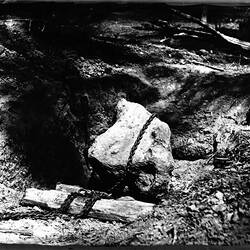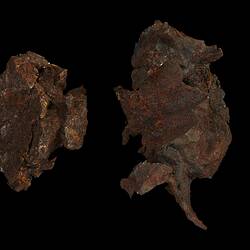Summary
This small sample along with another was taken from the base of Cranbourne No. 1 Meteorite by Alfred Selwyn on the 23rd of February 1862 when extracting and transporting it to the Museum (then situated on the ground of Univeristy of Melbourne). The 3.5 tonne meteorite remained on display outside the university quandrangle for the next three years. During this time it was the highly coveted prize at the centre of a tug-of-war between British and colonial scientists and government.
At the centre of the controversy was the Museums first Director, Sir Frederick McCoy who, along with much of Melbourne's scientific community agrued that the meteorite should remain in Melbourne.The discovery and later controversy surrounding the ownership of the Cranbourne meteorites is one of the most significant stories in the history of Australian science of the nineteenth century. The manner in which the narrative unfolded was particularly important to the fledgling Colony of Victoria, and the outcome which saw No. 1 sent to the Natural History Museum and the smaller of the two being retained here was a minor victory for colonial science and identity.
On the other hand, the loss of the larger meteorite to the British Museum must have felt like a stinging rebuke for the colonial scientists involved in the drama, such as Neumayer, McCoy, Selwyn and Macadam, as their counterparts in London obviously believed that the No. 1 meteorite was simply too important to remain in Melbourne under their immediate supervision. The controversy stands as an example of McCoy's belief that colonial science was just as valid as the practices at the centre of the Empire and that colonial Museum Collections should retain local specimens.
Specimen Details
-
Collection Names
-
Number Of Specimens
2
-
Specimen Nature
Form: Fragment(s) / Chip(s)
-
Name
Cranbourne No. 1
-
Class
-
Group
-
Type
Iron, IAB-MG
-
Minerals present
Iron oxides/hydroxides and possible nickel minerals
-
Specimen Weight
0.003
-
Date specimen found
1854
-
Collector
Alfred R C Selwyn - Geological Survey of Victoria (GSV), Cranbourne, Greater Melbourne, Victoria, Australia, 1862
-
Category
-
Scientific Group
-
Discipline
-
Collecting Areas
-
Type of Item
-
Keywords
Geospatial Information
-
Country
-
State
-
Nearest Named Place
![Cranbourne No. 1. [E 11504]](/content/media/25/898875-small.jpg)
![Cranbourne No. 1. [E 11504]](/content/media/25/898875-thumbnail.jpg)



